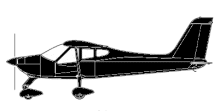
ASN Wikibase Occurrence # 215522
This information is added by users of ASN. Neither ASN nor the Flight Safety Foundation are responsible for the completeness or correctness of this information.
If you feel this information is incomplete or incorrect, you can submit corrected information.
| Date: | Saturday 1 August 2015 |
| Time: | 17:48 LT |
| Type: |  Tecnam P92 Echo Super |
| Owner/operator: | |
| Registration: | PH-4D3 |
| MSN: | 751 |
| Fatalities: | Fatalities: 0 / Occupants: 2 |
| Aircraft damage: | None |
| Category: | Serious incident |
| Location: | Lelystad Airport (EHLE) -
 Netherlands Netherlands
|
| Phase: | Approach |
| Nature: | Private |
| Departure airport: | Lelystad Airport (LEY/EHLE) |
| Lelystad Airport (LEY/EHLE) | |
| Investigating agency: | Dutch Safety Board |
| Confidence Rating: |
On 1 August 2015 a twin-engine turboprop Dornier Do-228 aircraft (D-IROL), conducting a non-scheduled commercial air transport flight from Texel Airport to Lelystad Airport, and a Tecnam P92 Echo Super microlight ({PH-4D3) nearly collided in mid-air near Lelystad Airport, the Netherlands.
Both flights were operating under visual flight rules (VFR) and in total 20 persons were onboard these aircraft. The microlight returned from a local flight on its way to runway 05 (grass runway) of Lelystad Airport. The twin-engine turboprop was approaching the main runway 05 (asphalt). It was not until a late stage of conflict that the pilot of the microlight could make an evasive action. The crew of the turboprop aircraft had not seen the microlight at all.
The investigation showed the limitation of the ‘see-and-avoid’ principle for air safety during VFR operations explaining the direct cause of the event.
Though evasive actions might prevent a mid-air collision, during approach and landing a successful evasive action can still be disastrous when resulting in an aerodynamic stall or loss of control whilst close to the ground. Therefore, in addition to the direct cause of this near mid-air collision, the investigation also focussed on the effectiveness of the ‘straight-in approach’ procedure to prevent near mid-air collisions in circuit areas or Aerodrome Traffic Zones (ATZ).
Additional findings of the investigation revealed that, in particular at uncontrolled aerodromes, safety is impaired when the executed flight path is non-compliant to the prescribed procedure. This also was the case with the twin-engine turboprop aircraft and another company aircraft which both flew to Lelystad Airport several times that day.
Non-compliance may also occur at other comparable uncontrolled aerodromes in the Netherlands where ‘straight-in approaches’ are allowed.
For this incident flight non-compliance likely was the result of misinterpretation of an ambiguous ‘straight-in approach’ procedure by the crew of the turboprop aircraft.
Furthermore, the ‘straight-in approach’ procedure of Lelystad Airport has officially been documented in an aeronautical publication, but its flight path was not shown on the visual approach chart. This also contributed to the non-compliance. Non-adherence to the prescribed ‘straight-in approach’ procedure increases the risk of (near) mid-air collisions with (other) aerodrome traffic.
The safety level of the passengers onboard the twin-engine turboprop aircraft was less than the usual standard for commercial air transport due to absence of radar service (separation) and a traffic collision warning system as a safety net.
Accident investigation:
 |
|
Sources:
OVV
History of this aircraft
Other occurrences involving this aircraft
| 6 May 2016 | PH-4D3 | Stichting SPE | 0 | Texel Airport, Noord-Holland |  |
sub |
Images:

Revision history:
| Date/time | Contributor | Updates |
|---|---|---|
| 20-Sep-2018 18:10 | harro | Added |
| 13-Jun-2022 02:33 | Ron Averes | Updated [Location] |
Corrections or additions? ... Edit this accident description
The Aviation Safety Network is an exclusive service provided by:


 ©2024 Flight Safety Foundation
©2024 Flight Safety Foundation